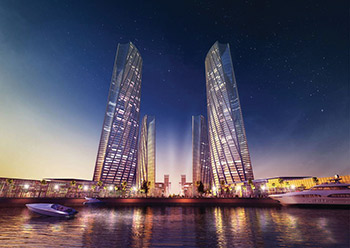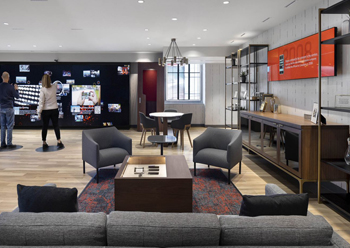
 Lusail Towers is envisioned as the catalyst for a new central business district in Lusail.
Lusail Towers is envisioned as the catalyst for a new central business district in Lusail.
An integrated approach to drive the design vision for the Lusail Towers is helping meet the complexities and the tight schedule set for the four striking high-rise development taking shape in Qatar’s new Lusail city, north of the capital Doha, says Foster + Partners.
The UK-based architectural practice carried out the architectural and environmental design alongside structural and MEP (mechanical, electrical and plumbing) engineering for the entire project.
Lusail Towers is envisioned as the catalyst for a new central business district in the city with a distinctive collection of four towers. The 1.1-million-sq-m development will host the headquarters for the Qatar National Bank, Qatar Central Bank and Qatar Investment Authority alongside several other global organisations including Qatari Diar, while creating a new downtown district that is sensitive to the climate and linked to a new transportation hub.
 |
|
At the base, several podium buildings surround each tower, with shops, cafes and restaurants that help animate the public realm. |
The project is part of a larger masterplan also designed by Foster + Partners, which is being completed ahead of the Fifa World Cup 2022 in Qatar.
The design of the towers and the podium buildings was influenced by climate, creating an intimate human-scale streetscape while responding to the city on an urban scale.
Foster + Partners’ unique integrated design approach was crucial in delivering a complex project within a demanding fast-track schedule. The project is underpinned by innovation, exemplified by the technological tools developed by the practice to assist the integrated design team.
Luke Fox, Head of Studio, Foster + Partners, says: “The complexity of the project and the compressed timescales meant that the exchange of information between architects, engineers and other consultants needed to be almost instantaneous. From the outset, we established an innovative approach by creating a single platform that communicated design changes in real-time, enabling our integrated team to work cohesively and at speed.”
Jonathan Parr, Senior Partner, Foster + Partners, comments: “Projects associated with major sporting events leave no room for delays. We knew from the beginning that to meet the challenges and the complexities of the project, we needed to approach the project differently, using technology to maintain consistency in the information flows across different disciplines.”
The team deployed an in-house software system called ‘Hermes’ that coordinates design data for the project and facilitates sharing of this data in real time across different applications, disciplines, organisations and locations around the world. Using specially created plug-ins for the different software applications used by architects, engineers and other consultants, design changes made by one group would automatically and instantly be available to the digital models being used by others.
 |
|
The tower façades are designed in response to the sun with projecting profiles that wrap around the building, shading the glazing from the harsh sun. |
“One of the most valuable contributions Hermes has made to our design process is to eliminate the need to manually rebuild models for different purposes. It allows us to work seamlessly across disciplines, facilitating prompt discussions between all the relevant individuals,” says Adam Davis, Partner in the Applied Research and Development team at Foster + Partners.
Located at the end of the grand boulevard that links the new football stadium to the corniche, the two taller towers stand at 70 storeys, while the other two are 50-storeys high, all arranged symmetrically around a central plaza.
Roger Ridsdill Smith, Head of Structural Engineering at Foster + Partner, says: “The elliptical footprints of the towers morph through 90-degrees as they rise up, gently shifting the viewing axis outward and offering stunning views of the surrounding city and waterfront. The structure remains symmetrical in plan through this morph, and comprises a central concrete core surrounded by 16 inclined columns around the perimeter, to create the unique geometry of the design. Wind tunnel tests were carried out early in the design process to inform the optimisation of the structure.”
The tower façades – clad in marine-grade aluminium – are designed in response to the sun with projecting profiles that wrap around the building, shading the glazing from the harsh sun, while providing daylight and preserving views out. The active systems design proposals include centralised thermal storage using innovative phase change materials to reduce cooling energy, high-pressure hydronic systems to reduce pumping energy, demand-controlled ventilation to reduce fan energy, efficient LED lighting and advanced automation controls which contribute to reducing the site energy demand by 35 per cent when compared to a baseline building.
In response to the increasing water scarcity in the region, grey water, rainwater and condensate is recycled and reused on-site for irrigation and toilet flushing, significantly reducing the demand for potable water. The Lusail Towers development targets four stars in the regional Global Sustainability Assessment System (GSAS).
At the base, several podium buildings surround each tower with shops, cafes and restaurants that help animate the public realm. These buildings feature moulded concrete panels, giving the buildings a high thermal mass, with minimal punched windows that reduce the amount of solar heat to the interior spaces, says Smith.
Some 20 per cent of the site is covered with lush but drought-tolerant landscape, where more than 70 per cent of the species are native. Inspired by the learnings from the region, the narrow human-scaled streets and shaded terraces create an inviting public realm at ground level, with the building blocks arranged around courtyards that capture cooling breezes, he explains.
Piers Heath, Head of Environmental Engineering, Foster + Partners, comments: “Environmental design was a key driver in the design. The morphing form was based on numerous studies and options with the aim of limiting solar exposure. The twisting shading fins were then developed to offer an optimal outer solar shade, along with an inherent reduction in exposed glazing. Coupled with carefully configured systems design, the project has lower energy use and carbon emissions when compared to similar scale projects in the region.”
Hyundai Engineering and Construction Company (Hyundai E&C), a major South Korean builder, is building two of the four towers in the development.
The project is being developed by Qatar’s Lusail Real Estate Development Company.





















_0001.jpg)


.jpg)
















.jpg)








.jpg)



